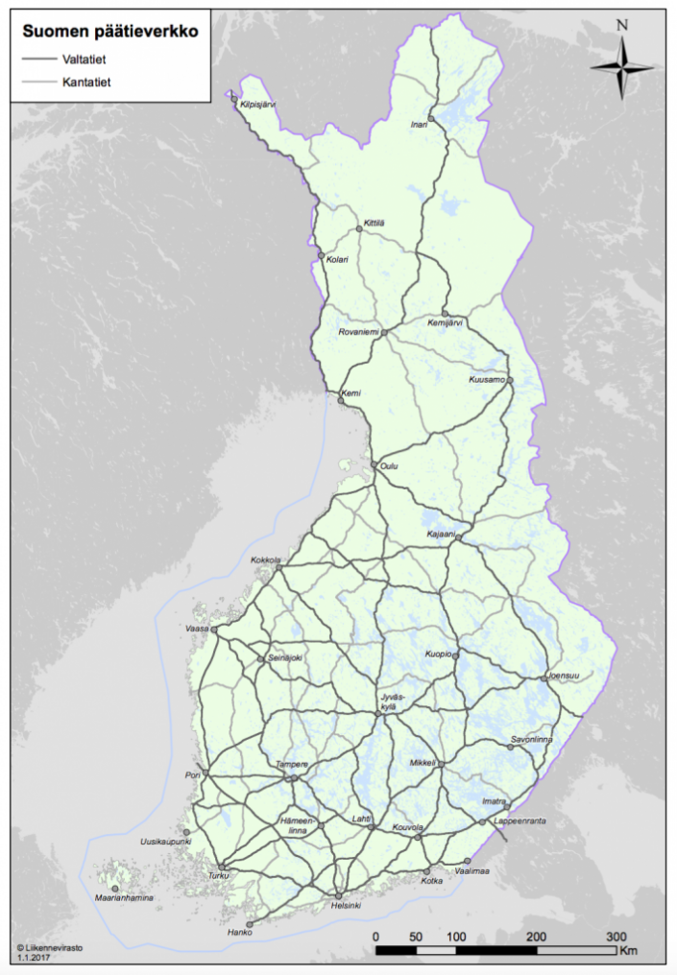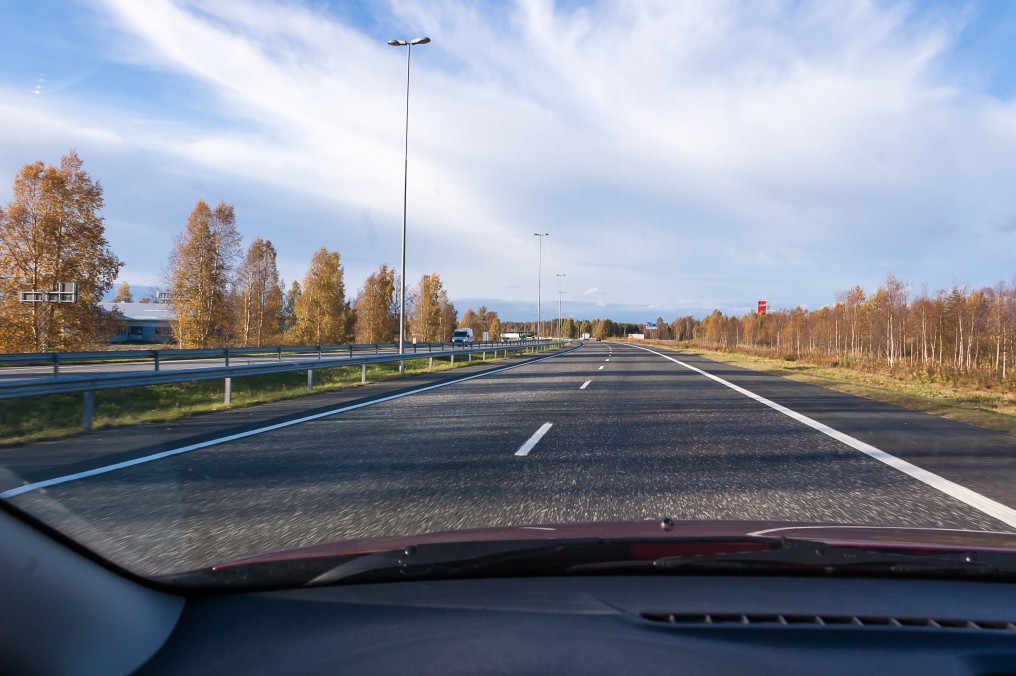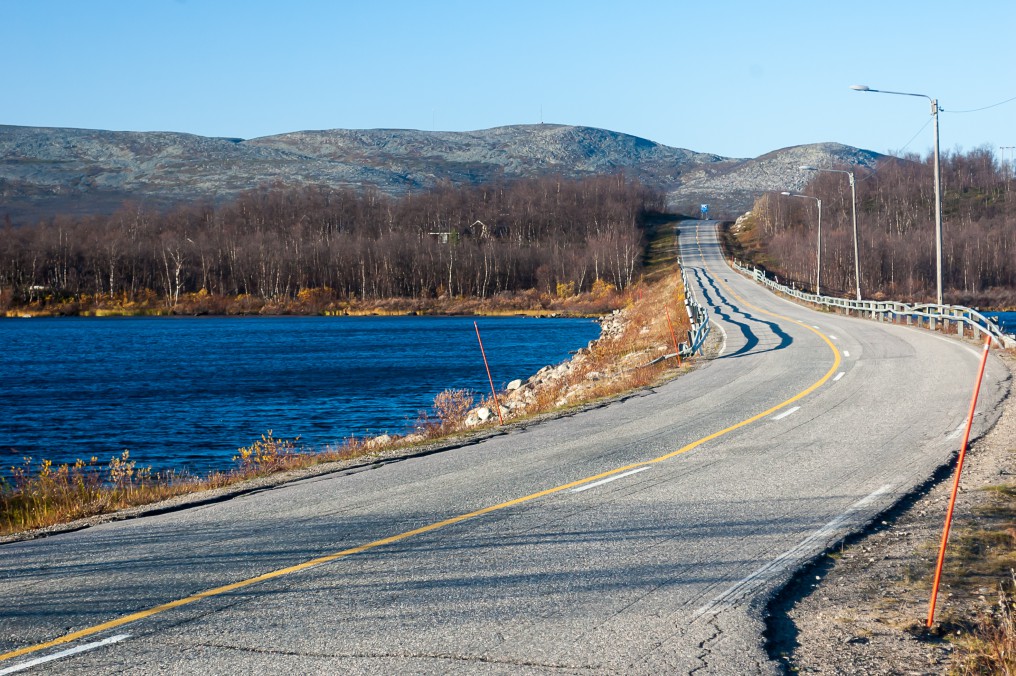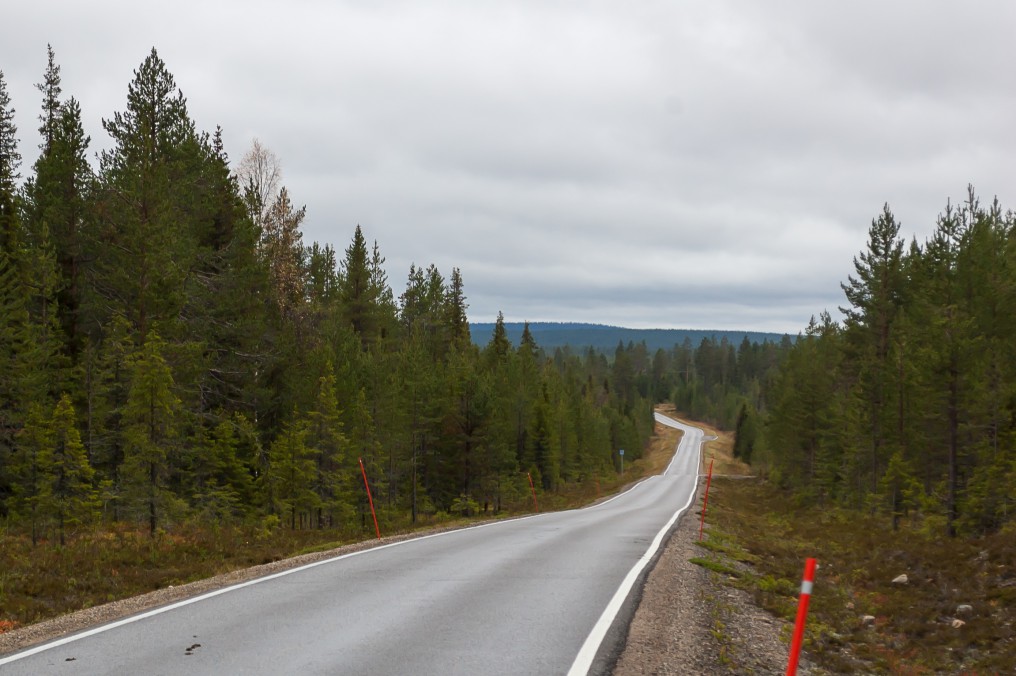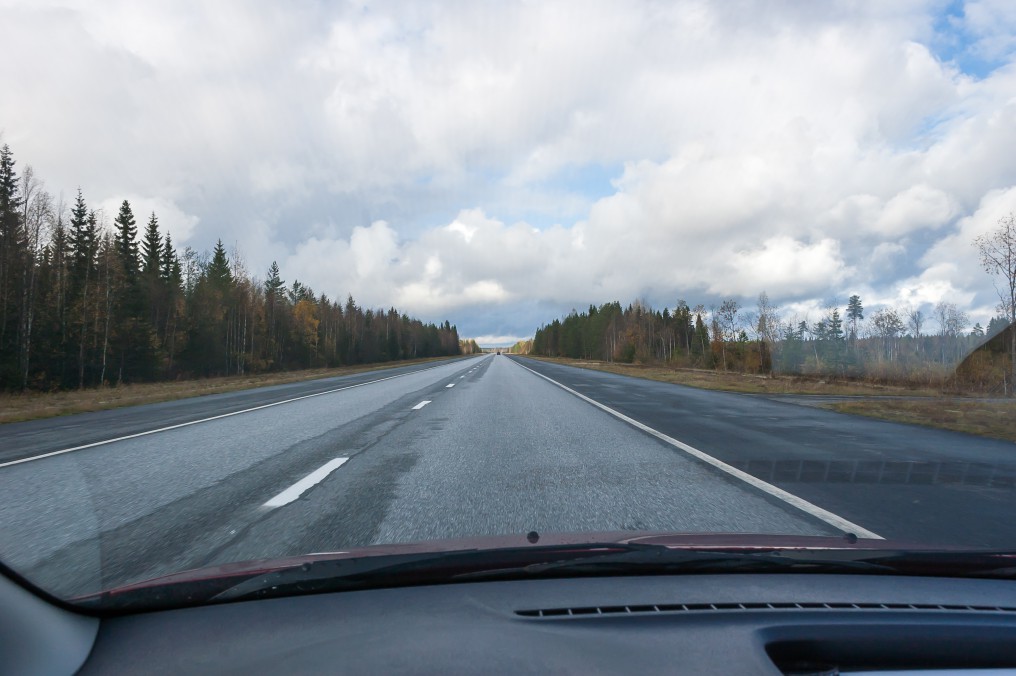Let's talk about Finnish highways. This is written from a Russian perspective and won't be a new subject for many St. Petersburg, Leningrad Oblast, and Russian Karelia citizens (and of course not for the Finns as well), but still there's quite a number of some interesting points to examine. This is mostly about highways only; we won't cover city parking, traffic jams, etc. As usual, all the pictures are mine, shot over 2015-2017.
History
Over the centuries Finland had historically been known for its poor (or non-existing) roads, just like Russia. I once read some travel notes by an Englishwoman about Finland, dated to the beginning of the 20th century; she was writing that roads basically did not exist, and no one seemed particularly concerned about that; after all, snow covers everything for like half a year anyway.
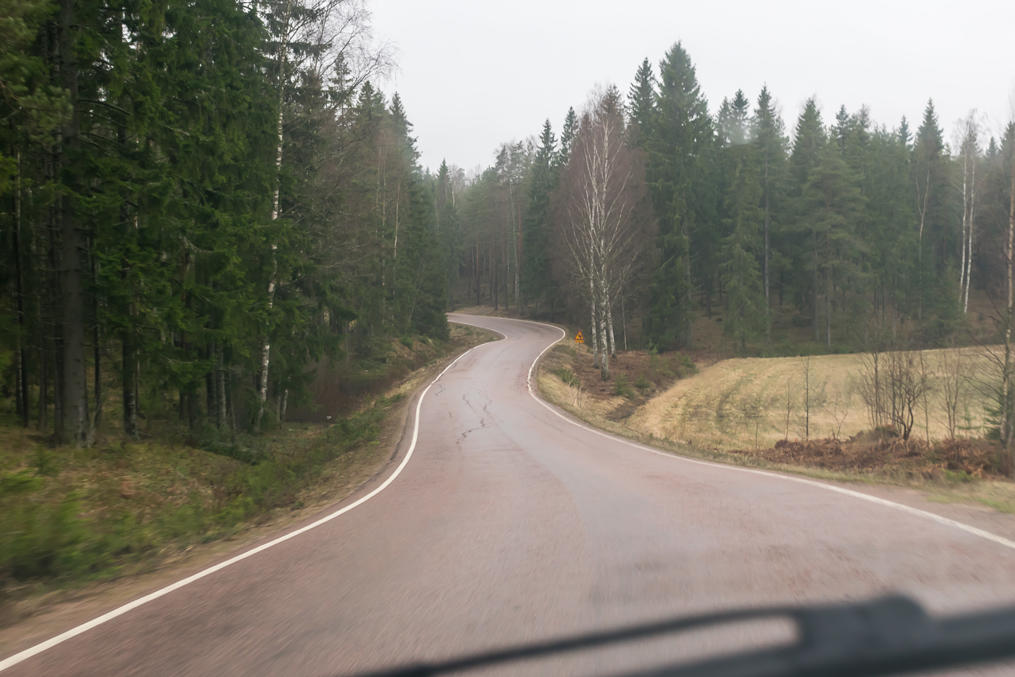
Anyway, since 1921 the young Finnish state assumed the responsibility for hightway construction and maintenance. The plan for the basic national road network, consisting of 30 highways, was first drafted in 1933 by Kyösti Kallio, the future Finnish president (1937-1940 term). For the most part this plan is still in force even today.
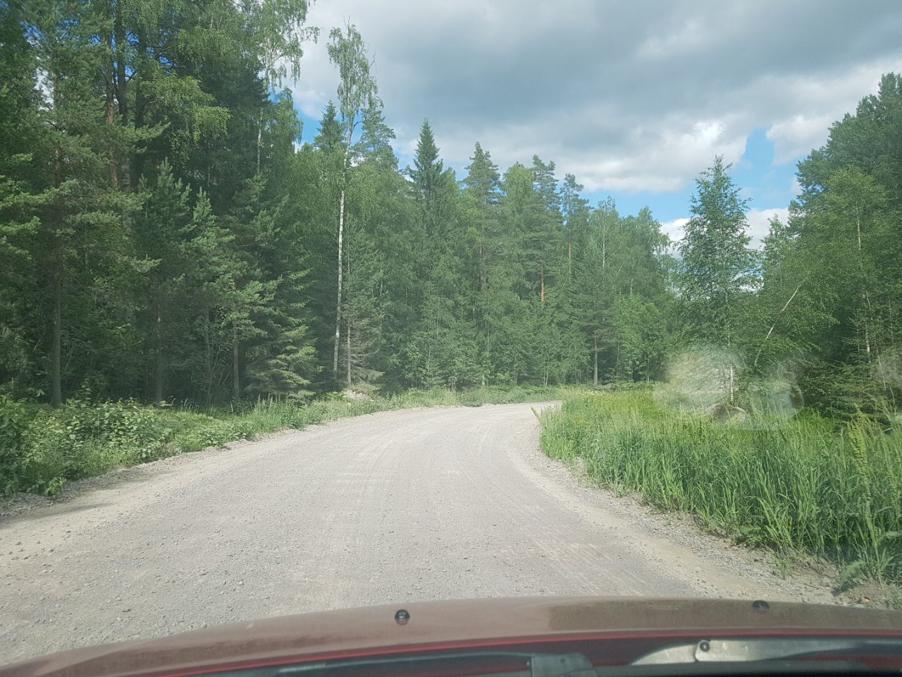
Not many highways were built before the war, and pavement outside of cities didn't exist at all at the time. After the wars, Karelian Isthmus and Ladoga Karelia roads of course were passed to the USSR; most of them still exist, although mostly as minor regional roads; some of them are still unpaved like the one pictured above. Meanwhile the big road network plan had to be updated a bit (in particular, Imatra-Joensuu section had to be added instead of lost Imatra-Sortavala and Sortavala-Joensuu roads).

The big scale highway construction took place in 1950-60s. Just like in the US, apart from the obvious merits of having some good highways, this was an important employment project. The pavement began to appear, too; Helsinki-Turku highway was completely paved by 1960. Less important roads got their pavement only much later.
![National Road 5 ([Helsinki]-Mikkeli-Kuopio-Kajaani-Kuusamo-Sodankylä), a motorway section (Kuopio city bypass) in North Savo](/blog/2017/09/images/20150926-DSC_3913.1x.jpg)
The first Finnish motorway was built in 1962 (Länsiväylä, the Western Highway, connecting Helsinki with its major suburb of Espoo). Only suburb motorways and city bypasses were being built at the time. Intercity motorway construction was meant to begin in the 1970s, but the worldwide oil crisis of 1973 put these plans on hold for many years. Some wide-lane roads ("1.5+1.5") were built in the 1980s but these never got very widespread due to their high accident rate. Motorway construction mostly resumed since the 1990s. The national highway network is at the moment considered more or less complete; motorway and interchange construction continues on but no really major projects are planned for the foreseeable future, and it's been many years since any major roads were built from scratch.
Highway network
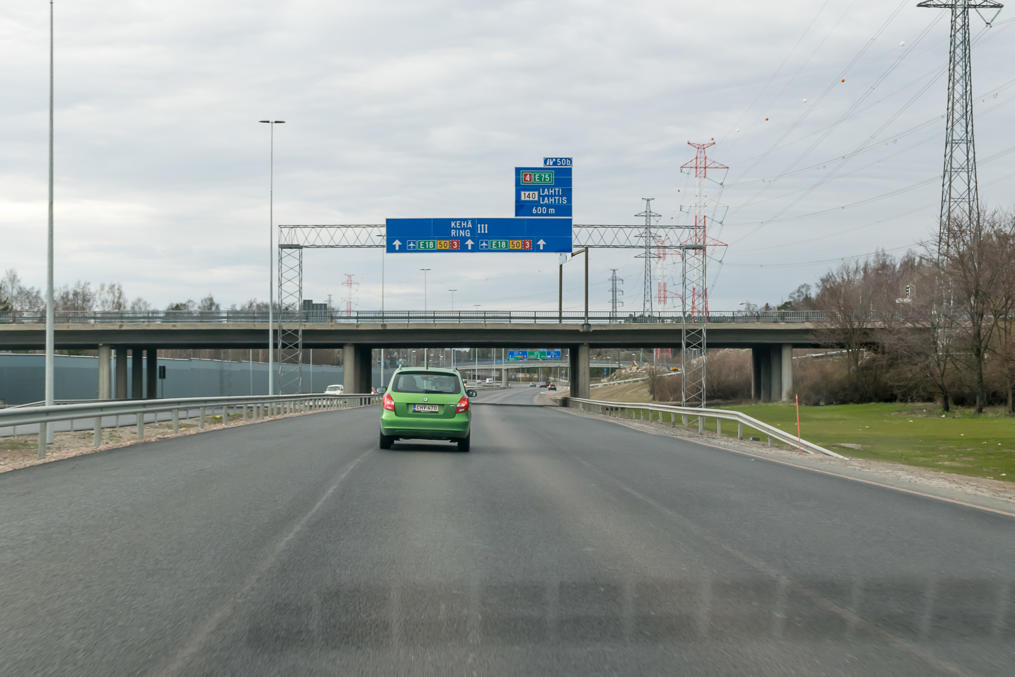
The highway network of Finland is organized in a very logical way. The highways are divided in four categories. All highways in the country are assigned a unique number, which is very convenient for navigation (Sweden and Norway could take a note here!). Within a category, road numbers generally increase towards the north of the country.
1. National roads (valtatie), number 1–29, signposted on red background. The skeleton road network. If you're driving long distances in Finland, you'll almost certainly be using these highways for the majority of your journey. Nearly all motorways are national roads as well. Roads 1-7 spread radially from Helsinki, 8-10 go from Turku, and 11-13 go from Tampere (Helsinki, Turku, and Tampere are the three biggest cities in Finland). The remaining roads connect other major cities and directions. The longest road of the entire country is the National Road 7, going all the way from Helsinki to the Norwegian border in the north, for 1295 km.
2. Main roads (kantatie), number 40–99, signposted on yellow. Secondary connections of the main network, approaches to minor cities, and to state border crossings. They do not differ from national roads in quality.
This is the scheme of all national roads and main roads of the country. Notice how dense the network is; there are multiple possible routes between most destinations. Thus the traffic is spread fairly evenly, and most of the roads do not come close to their capacity (and do not wear out quickly as well). There are no unpaved stretches or ferry crossings on this network. It is particularly noteworthy that this network is maintained even though there are no cities bigger than 200,000 population outside of Greater Helsinki area (well okay, Tampere is 215,000), and the vast majority of the cities are smaller than 100,000. As a Russian, the density of the road network is what I consider the greatest feature of Finnish roads; while our own main highways are getting better, there are still just too few of them, and many secondary Russian roads are in deplorable conditions wherever they exist at all.
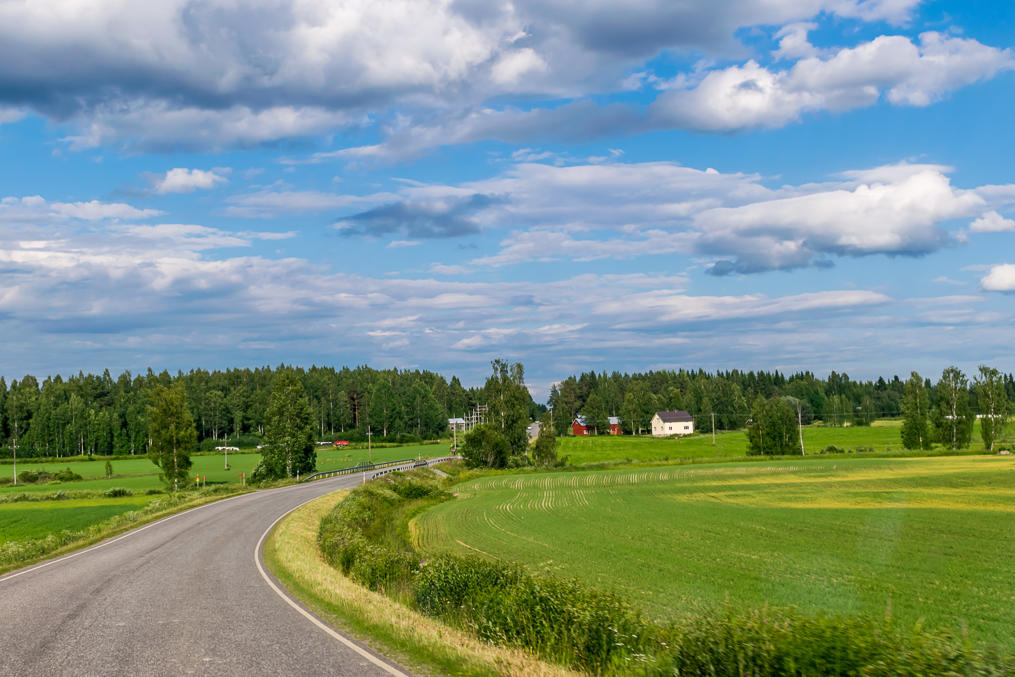
3. Regional roads (seututie), number 100–999, signposted on white. Minor roads, old alignments of new roads, and approaches to very small towns. The quality of these roads can vary quite a bit; some of them are indistinguishable from national roads, while others can be narrow and extremely curvy and hilly; there are even some one-lane roads with passing spots. Some regional roads lack pavement but this is uncommon; only 2-3% are gravel roads. Roads 101 and 102 (Ring I and Ring II of Helsinki), and Roads 110, 120, 130, etc. (older alignments of Roads 1, 2, 3, etc.) also belong to this category.
4. Connecting roads (yhdystie), number >1000, signposted on blue but most commonly number is not signposted at all. Very short connecting routes and approaches to villages. Mostly a lot like the regional roads, but the fraction of unpaved roads gets much higher here.
There are also some private roads (signposted on black if at all, not numbered). They are maintained by private entities rather than the Finnish state, but unless there is a boom gate or an explicit forbidding sign, you can still drive on them. (The "right to roam" is a pretty big thing in Finland.)
The total length of the state highways is 78,000 km; there are also 26,000 km of streets and other urban roads, and 350,000 km of private roads (the vast majority of these are logging roads).
There are no tolls of any kind on Finnish roads (not even for trucks). There are no toll bridges, tunnels, or city congestion charges, and no plans to introduce any of these.
No countrywide bike path network exist; bike paths (sidewalks really) usually end outside city limis (sometimes they can connect two towns if they are really close). Biking on regular roads is generally not a problem, since the traffic is usually moderate at worst. All motorways and other roads off-limit to bikes have alternate older bike-accessible roads.
Motorways
Finland doesn't really have a big motorway network, just about 760 km of them (maybe a bit more by now). The population density is mostly too low (lower than most regions of European Russia) to justify motorway construction. A few of the radial roads spreading out from Helsinki are motorways (Road 1, Helsinki-Turku; Road 3, Helsinki-Hämeenlinna-Tampere; Road 45, Helsinki-Tuusula; Road 4, Helsinki-Lahti-Heinola; Road 7, Helsinki-Porvoo-Kotka-Hamina). There are also some motorway bypasses of major Finnish cities (Vaasa, Joensuu, Kuopio, etc.), and a few isolated motorway sections (Road 6, Lappeenranta-Imatra; Road 29, Kemi-Tornio).
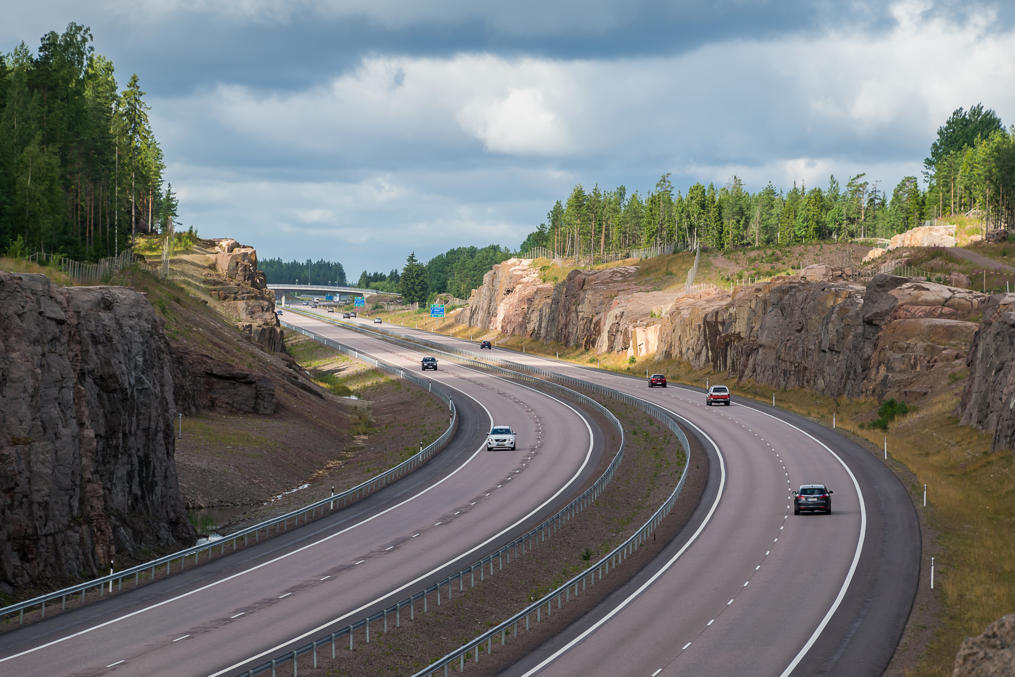
Curiously, Finland has really strict definitions on what consitutes a proper motorway (with green road signs). Most of the Lappeenranta-Imatra stretch, for example, is not officially a motorway and has only regular blue signs, although it looks just like a motorway (and has motorway speed limits). I have no idea why, but presumably it still doesn't meet some standard.
Some wide lane roads ("1.5+1.5") exist (e. g. Road 4 Oulu-Ii, parts of Road 6 Kouvola-Taavetti), and so do roads with passing lanes ("1+2", e. g., parts of Road 5 Mikkeli-Kuopio) but neither are very common.

At the moment Taavetti-Lappeenranta and Hamina-Russian border motorways are under construction. There are plans for more stretches but nothing really big. Anyway the only roads in Finland that really feel overloaded are the middle parts of Roads 4 and 5 (near the cities of Jyväskylä, Kuopio, Iisalmi) which are the longest roads in the country.
Gravel roads
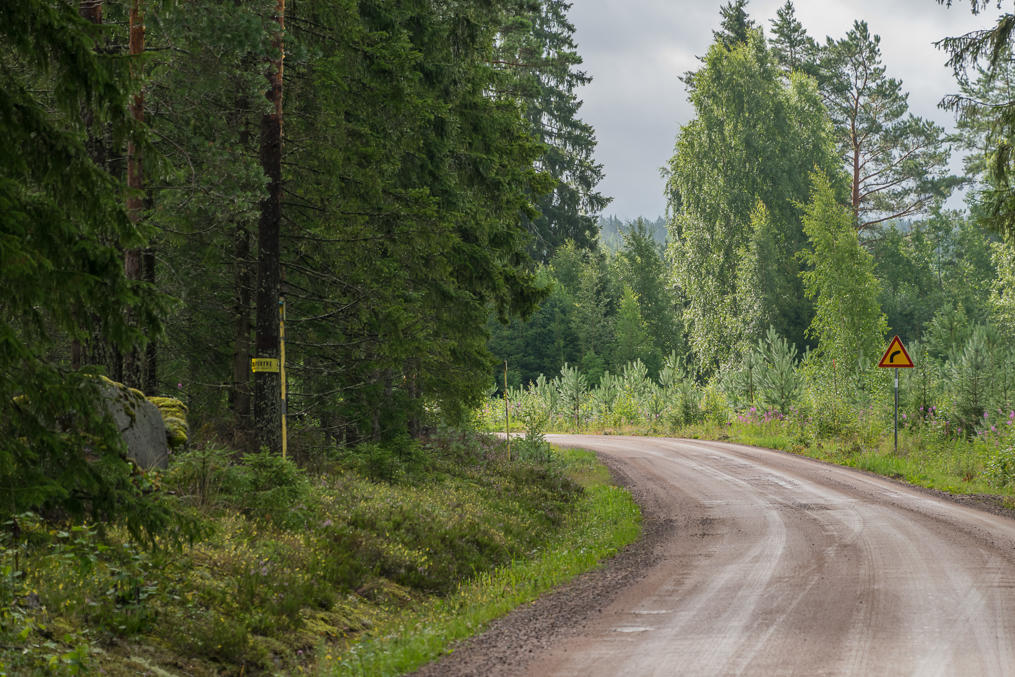
Minor roads in Finland often have only gravel coating. They are still well-maintained, and the traffic on these roads is usually extremely light, so all of these roads are easily passable on any car. Only spring season can be a bit problematic.
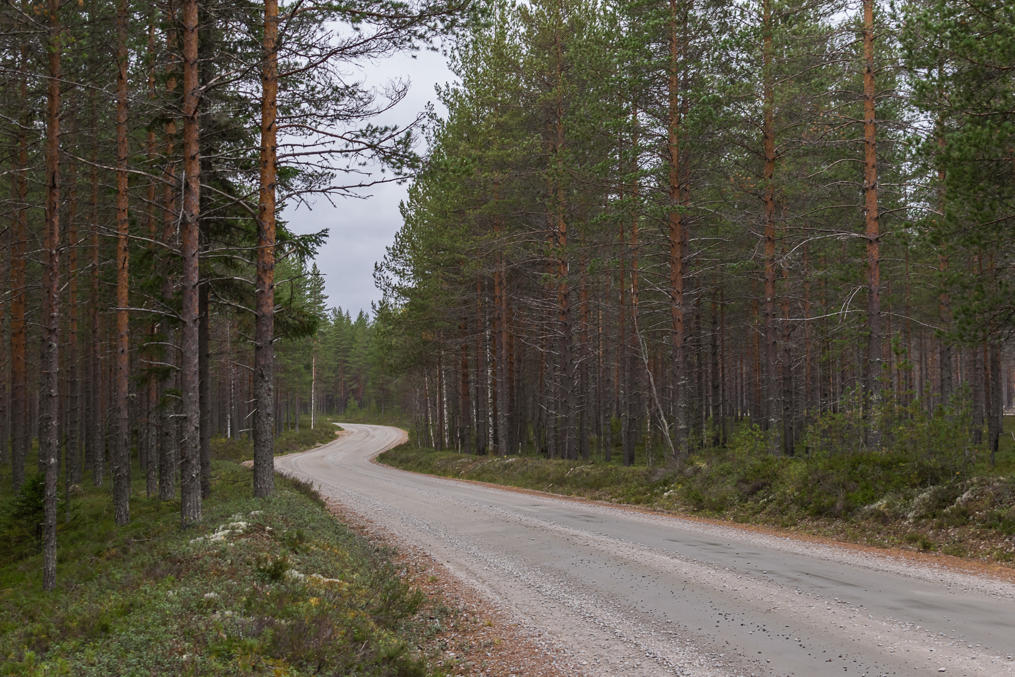
The forest is the "green gold" of Finland and its only major natural resource. There are more forests in Finland than in any other Western Europe country. Logging is thus a major industry (of course it is being done in a responsible way, cut forests always get replanted, and the overall wood balance is actually positive), and most forests have a lot of unmarked logging roads. Even these are maintained rather well and have a gravel coating (well, maybe some of them don't, but so far I haven't seen any evidence of that) and are passable on any car, which is very convenient if you're into collecting mushrooms and berries. These roads usually do not lead anywhere in particular, and end with a big loop in the middle of the forest so that logging trucks can turn around.
At the same time, off road driving in Finland is strictly prohibited. So buying a 4WD car here makes exactly zero sense :) Of course there is an exception for people who need to do it for the living; e. g. reindeer herders in the north can drive across tundra on quad bikes in order to, well, herd reindeer.
Speed limits

The standard speed limit outside of cities is 80 km/h. On national and main roads away from cities and villages signs usually raise the limit to 100 km/h. In practice most drive about +10% to the limit (and the Russian drivers driving 10 km/h slower than the limit really annoy everybody). Actual speeding does happen but is very rare. Mostly everybody (at least car drivers) drives about the same speed, and the traffic moves very evenly.
I almost like 80 km/h limit even better than 100 km/h, as this is slow enough that you don't need to overtake any trucks. Although there aren't many semi trucks on the roads in general. Only some RVs (and tractors of course) drive slower than 80 km/h. Unlike in Russia, there are no overloaded trucks which drive very slowly and clog roads.
The motorway speed limit is 120 km/h. A lot of people drive slower (probably to conserve fuel) but of course overtaking them on a motorway is trivial. The limit is lowered to 100 or even 80 km/h near cities. Electronic speed limit signs are used on some motorways so that the limits may change according to road conditions. These signs are usually also accompanied by billboards showing air and pavement temperature, which is meant to warn you of possible black ice conditions in advance.
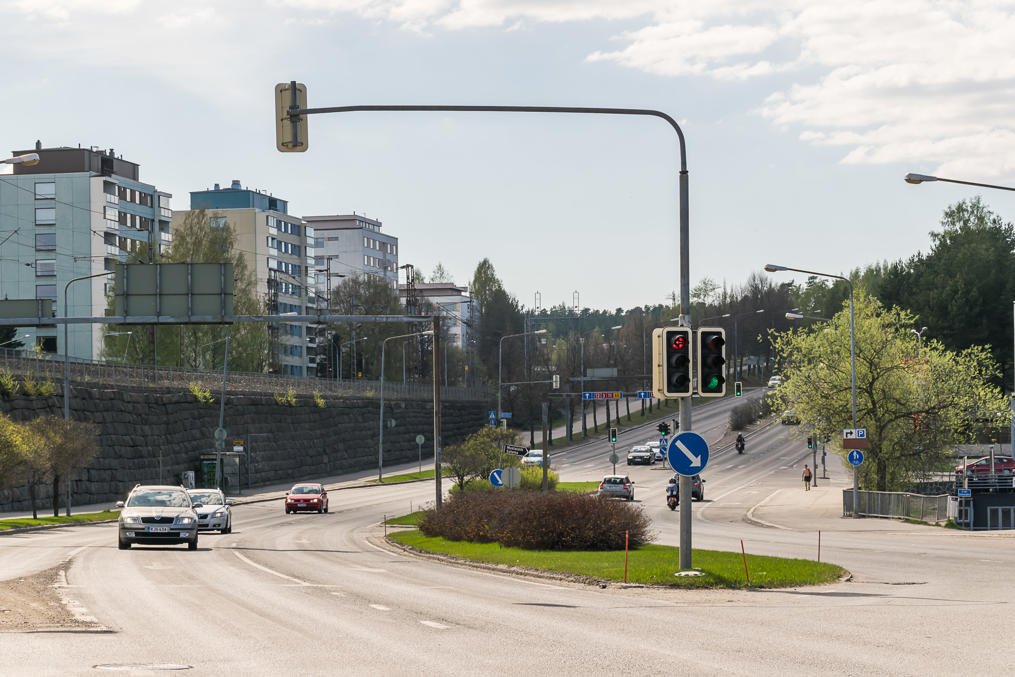
Within populated areas the general speed limit is 50 km/h, usually lowered by signs to 40 or even 30 km/h in city centers and residential areas. However, if a road passes through a city but doesn't have many intersections with its streets, 60-80 km/h limit is often retained, and no "populated area" sign is used. Pedestrian crossings on roads with speed limit above 50 km/h or outside of populated areas are extremely rare; either there are traffic lights, or pedestrian underpasses (with very gradual slopes, suitable for any bikes, baby prams, or disabled people), or nothing at all, so that the pedestrians may cross the road wherever convenient, yielding to road traffic. Pedestrian crossings never occur on roads with speed limits greater than 60 km/h. Pedestrians usually wear clothing with reflective patches and are easy to see. When the speed limit is lowered, the sign is often duplicated with a big number on the road surface, so that it would be more difficult to miss.
In winter (approximately from November to April if I'm not mistaken) lowered speed limits are in effect; no more than 80 km/h on regular roads and 100 km/h on motorways. The exception are national roads in Lapland, where some very straight and remote stretches retain 100 km/h limits despite being regular 1+1 roads. Road services literally go and change all the signs twice a year (well actually 80/100 km/h sign can be just flipped aroud). In general, when you enter a road, the speed limit sign will almost always be installed right after the intersection.
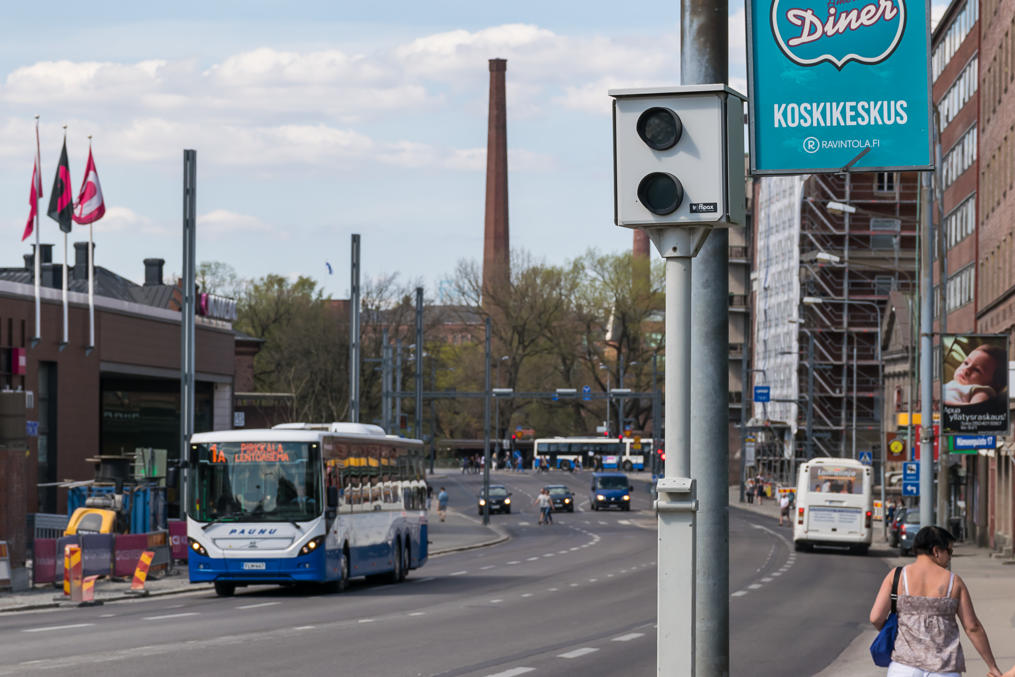
Speed limits are enforced by cameras on some roads. "Camera" sign is always posted on these roads, and signs before the cameras usually remind you of the current speed limit, so these are pretty difficult to miss. Using or even owning a radar detector in Finland is illegal however; these will even be confiscated at the border if you attempt to enter the country with them. I'm not sure what is the exact speed when the cameras trigger but I believe +5 km/h is already enough for a fine.
Traffic fines for the Finns themselves are proportional to their income, which I believe is the unique feature of the country. So there are occasionally news stories of some sportsman or executive getting a fine tens of thousands of euros big. People from abroad only get the minimal possible fine, but even these fines are fairly hefty. Well I'm not sure about the details, I've never driven in Finland in such a way so I could be fined :)
Apart from the cameras it doesn't seem that traffic rules are really enforced in any way, but people obey them all the same. Police traps may occur but are extremely rare (sometimes they test everyone for drunk driving etc.; 0.05% is the local BAC limit, which is bigger than in Russia where it's about 0.035%). Probably if you go 200 km/h or drive as if drunk senseless someone will phone the police and you will get caught. But it's not like everyone is going to rat you out on the slightest infraction.
Temporary speed limits are of course posted at roadworks sites. These are less ridiculously low than in Russia but are still often ridiculously low, and no one seems to be really completely obeying them. So that's one thing in common with Russia :)
Ferry crossings
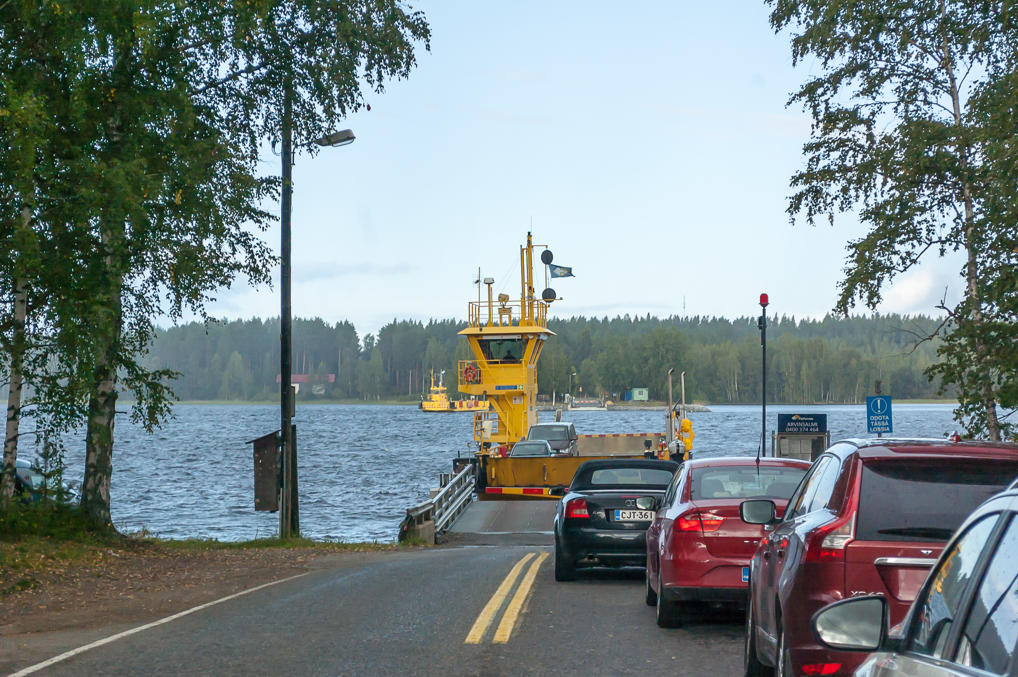
An interesting feature of the highway network is ferry crossings. A few dozens of these exist throughout the country, with varying size (pictured above is about the smallest ferry you're going to see). These are mostly used to reach some inhabited islands in numerous sea archipelagoes, and over narrow straits in lake mazes in the southeast of the country. There used to be a lot more ferries in the past but they have been replaced with bridges over time. This process is still ongoing; at the moment, for example, they're planning to build a bridge to Hailuoto Island near Oulu instead of a ferry crossing.
Using ferries is totally free! You just drive to crossing, wait in line if necessary, drive on board (following the directions of the ferry staff and/or traffic lights, if available), wait for a few minutes, and drive off on the other side of the strait. Some bigger ferries have timetables, while others just operate upon demand; if you're the first at the crossing, and the ferry is at the opposite side, there is a button you can press to call the ferry.

There are some toll ferries but these are an exception. For example the Koli-Lieksa ferry across the Pielinen Lake is not free, because this is a private ferry. The big ferry at Houtskär-Iniö crossing of Road 180 is tolled too, and is the only tolled ferry on the state road network that I know of. This road is a little unusual; it is the Archipelago Ring Road, which hops between islands all around Turku and has numerous ferry crossings. The tolled ferry closes the biggest gap between islands. Unlike most ferries it operates only in summer too, so I couldn't drive around the entire ring road back at the time :)
Even bigger ferries to Åland Islands and of course the cruiseferries to Estonia and Sweden are paid for too.
Road maintenance
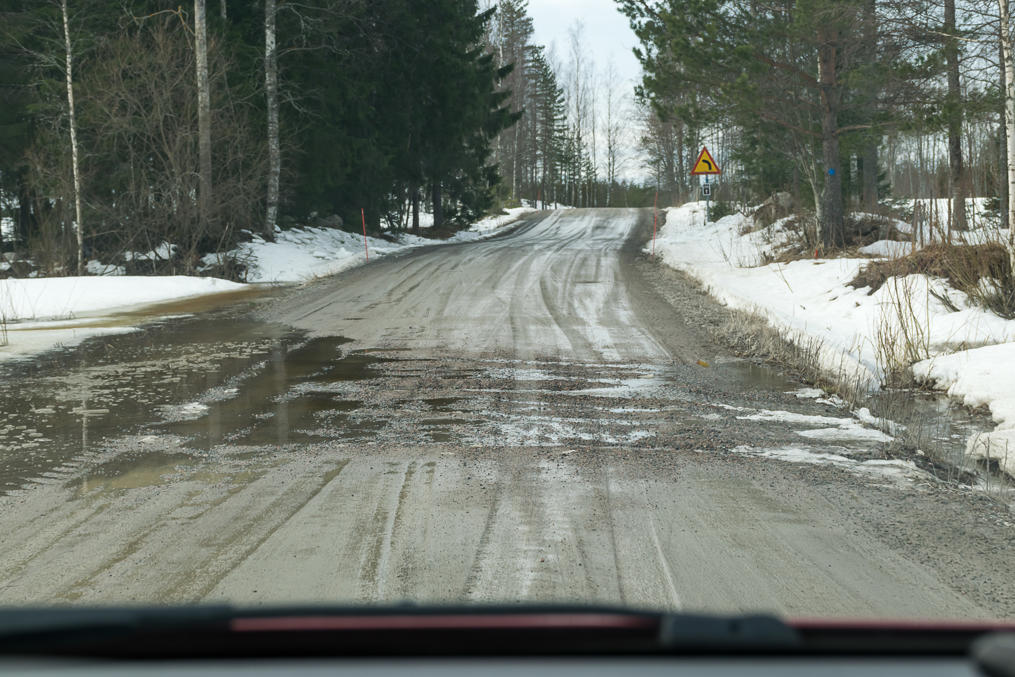
Finnish roads are not perfect of course. Absolutely perfect road surface is more of an exception rather than the rule; it is usually worn out and/or patched up to some extent. Nonetheless, I'd express it like that: it is virtually impossible to find a paved road in Finland that would be difficult or even uncomfortable to drive at the general speed limit (80+ km/h) due to any damages or wear of the pavement. Sometimes very very rarely you can find some small isolated potholes (especially in spring) but these get patched very quickly. Only gravel roads in spring rasputitsa season can get a little difficult but these should still be driveable too. Isn't it funny that rasputitsa is a Russian word? Finnish language however has an unrelated word for it: kelirikko.
The Finns are a pretty thrifty bunch in general, and it is common, for example, to just cut out two long rutted strips and replace pavement there instead of resurfacing the entire road. The road thus repaired doesn't look very pretty, but the important thing, you can drive it at any speed safely again.
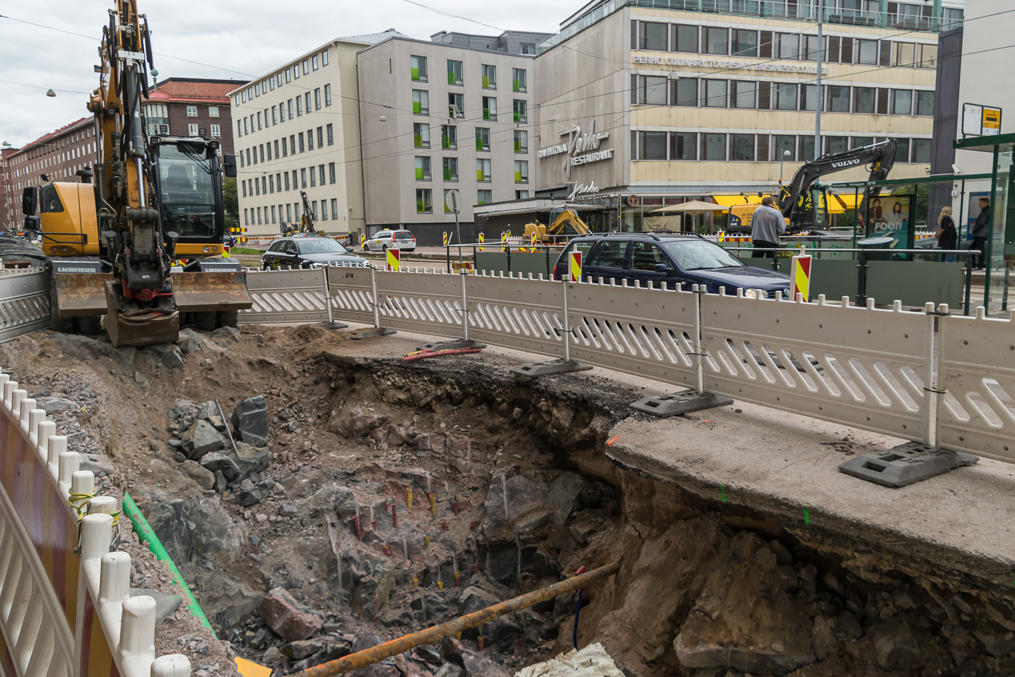
The entire Finland is mostly flat and located pretty much directly on top of the solid ancient bedrock (the so-called Baltic, or Fennoscandian Shield), which of course makes a good foundation for road construction. Nonetheless the topography of the country has lots of small hills, rocky outcroppings, glacial moraines, erratic boulders, and other minor annoying landforms. A road built just on top of all that would be really curvy and hilly (and most minor roads actually are). Thus some rock blasting is usually necessary to construct a good and reasonably straight road, and motorways sometimes even require tunnels (other than that there are nearly no tunnels in Finland). And sometimes it is necessary to build roads through mires or even lakes, because Finland is chock full of these.
Lapland has some spots of permafrost, but as far as I understand these are only spots and do not affect road construction much.
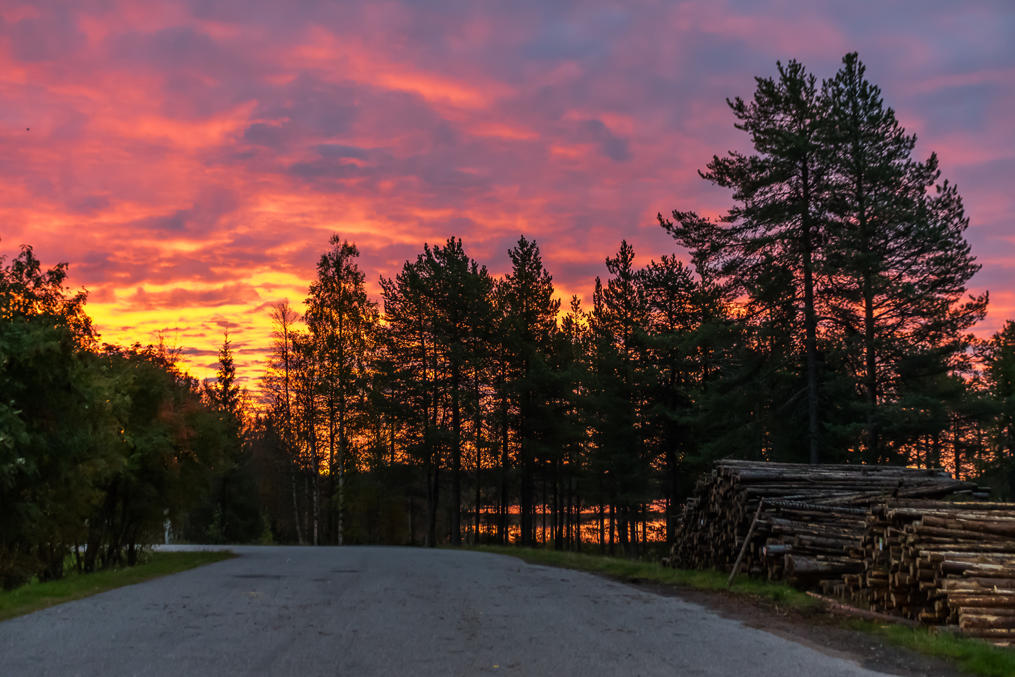
Highways (unless they are motorways) usually don't have a wide dirt or gravel shoulder as they do in Russia. If you want to gather some mushrooms or something it's best to turn off into the forest on some logging road (which are pretty common as I said before) or find a rest area. The rest areas are usually really spartan (unlike in Sweden). A toilet is almost unheard of; if you're lucky there'll be a garbage bin. They are not very common as well. Of course various roadside sights, restaurants, hiking areas, etc. always have ample parking space.
Winter
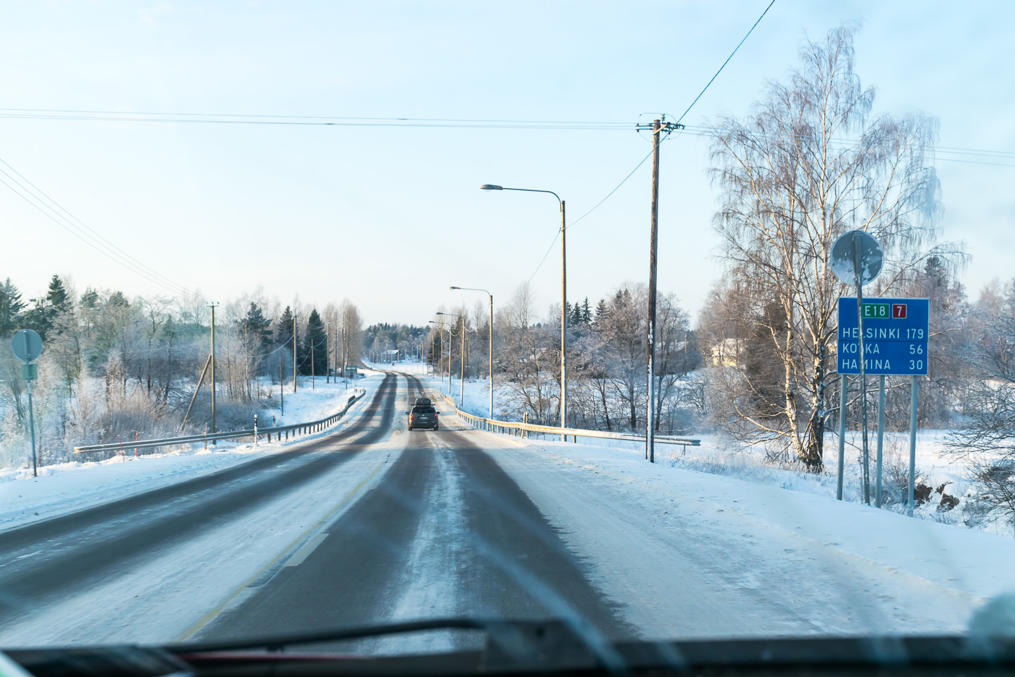
Finnish climate is of course nowhere as harsh as Siberia or Alaska, but the comparison with the European part of Russia is quite valid. Most coastal areas have climate resembling St. Petersburg or slightly more marine, with even milder winters and cooler summers. Further inland and up north in Lapland the climate gets much harsher; +30 in summers and -35...-40 in winters are not unheard of. Road winter maintenance in the south and in the north thus differs.

In the south roads get salted and de-iced, just like in Russia. I've got the impression that the Finnish road salt is stronger than Russian one but used more sparingly. On the motorways, for example, it's not uncommon to see a thin layer of snow on the left (passing) lane. Overtaking on snow seems dangerous although the local drivers do not seem to mind.
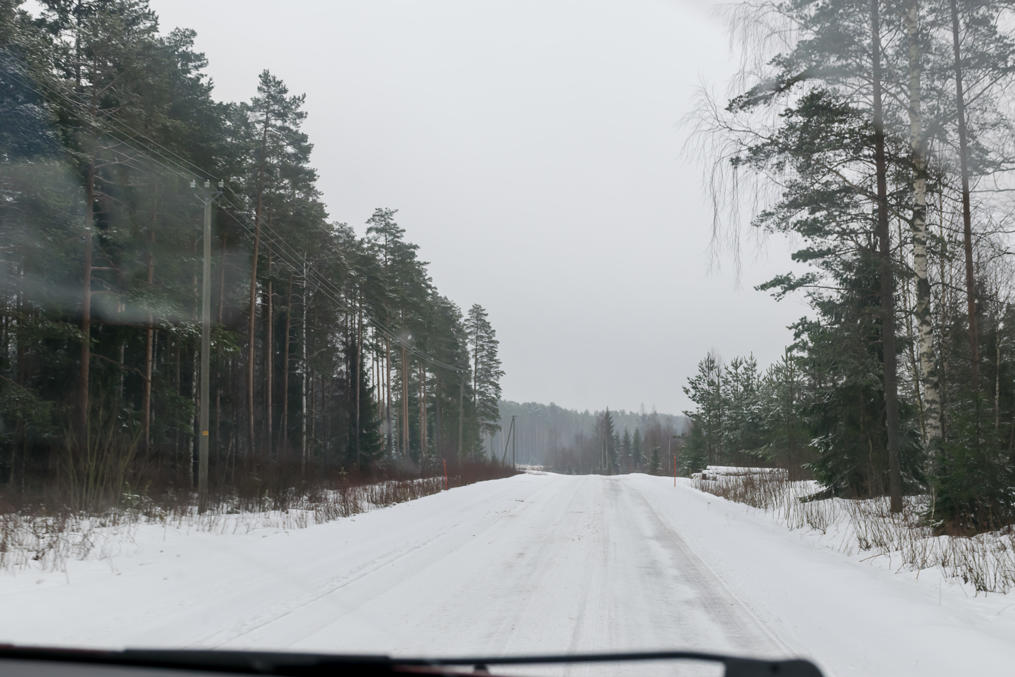
Very minor roads usually just retain a layer of packed snow instead, like that.
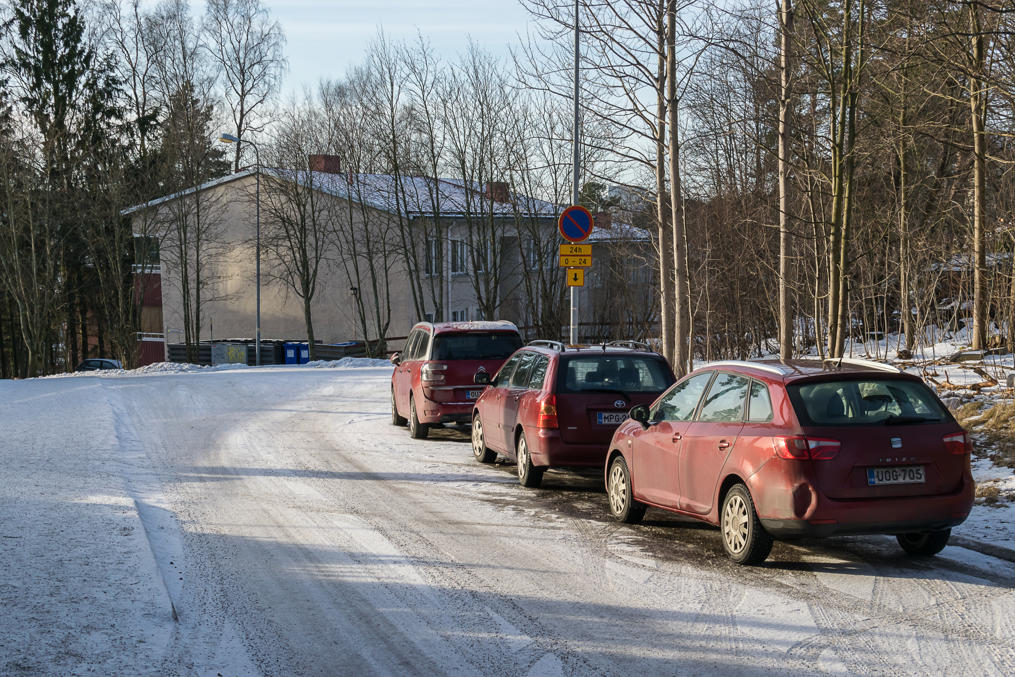
On sidewalks and small streets in residential areas crushed granite gravel is used instead of salting. Thus Finnish cities often look a lot tidier and cleaner than Russian ones even in winter (although cars still get dirty). The gravel gets collected back in spring; sometimes it's left around for quite a while after all the snow already melted, which hurts the aesthetic a bit. Crushed granite is never used on major streets or on highways; it would shatter all the windshields around.
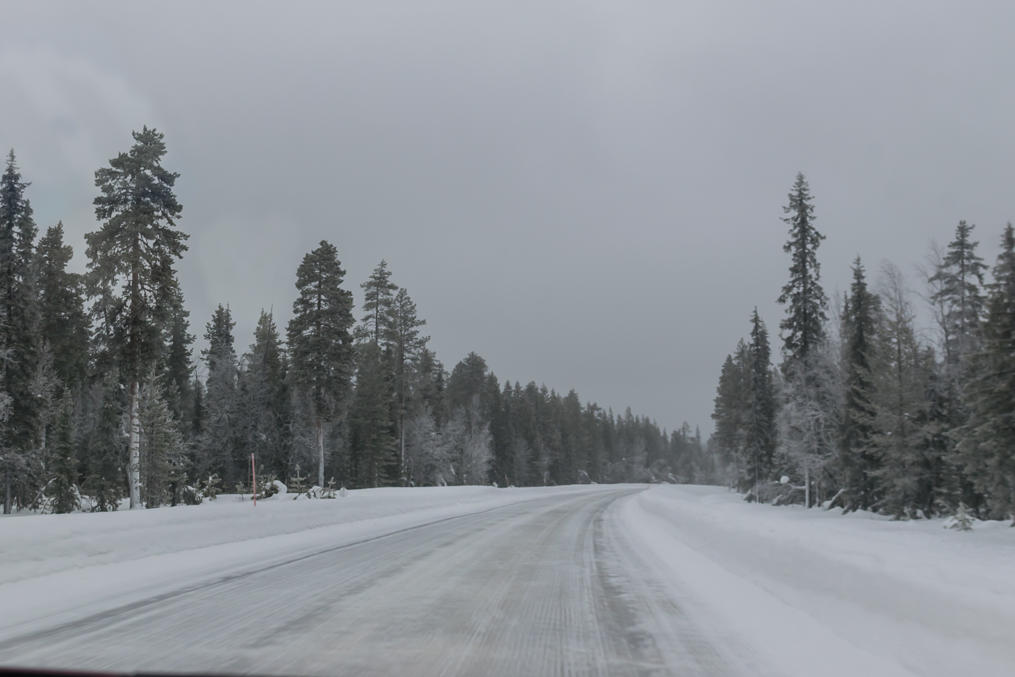
Lapland has colder and more "proper" winters, with much less of a black ice danger, thus things are somewhat simpler here. Salt is never used here at all. Major highways just get plowed to the pavement (with some packed snow remaining as in picture), and secondary ones just have packed snow. You'd better not drive here without studded tyres! And if you're used to roads which remain wet and snowless even in -20 degrees (as is common here in St. Petersburg) it looks and feels quite scary. Nonetheless such a road is fairly safe to drive, provided you never make any abrupt maneuvers and maintain really respectable distance to other traffic (which is very light to nonexistent anyway).
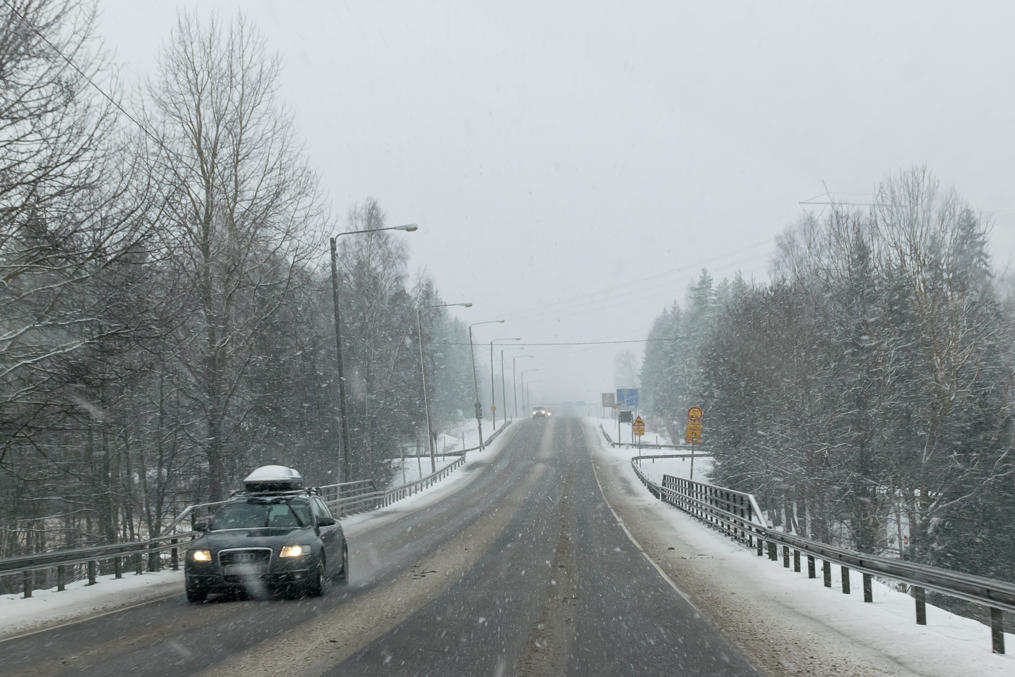
All highways in Finland are open around the year. While some minor roads in Norway get completely closed for winter, and even major highways sometimes have to be closed due to nasty snowstorms, in Finland nothing of the sort normally happens even in Lapland. Many private forest roads may not be plowed at all though.
Ferries, to the best of my knowledge, work around the year too (provided the sea conditions are not too rough and stormy). There are some ice roads, for example, the private Koli-Lieksa ferry crossing gets replaced with an ice road across the lake in winter. But these are rare and are usually of a very marginal importance.
A network of snowmobile track also operates in winter. Of course this is again mostly about Lapland; you can often see snowmobile tracks crossing the highways there (of course a snowmobile yields to any road traffic on such a crossing). Curiously, unlike the roads, snowmobile tracks are usually tolled! I have no idea how this works in practice, and how and to whom you need to pay.
Wildlife
For some reason it is much more common to randomly see wild animals in Finland than in Russia. For example I've never seen a hare in Russia but encounter them in Finland on a rather regular basis. Once I almost hit one with my car; it jumped away at the last possible moment. Would've been really sad. I've also seen owls and foxes while driving at night; and twice I actually hit birds suddenly flying across the road. First time it was a grouse, second time a duck, I think. That was sad too although the birds survived (at least initially) and managed to fly away.
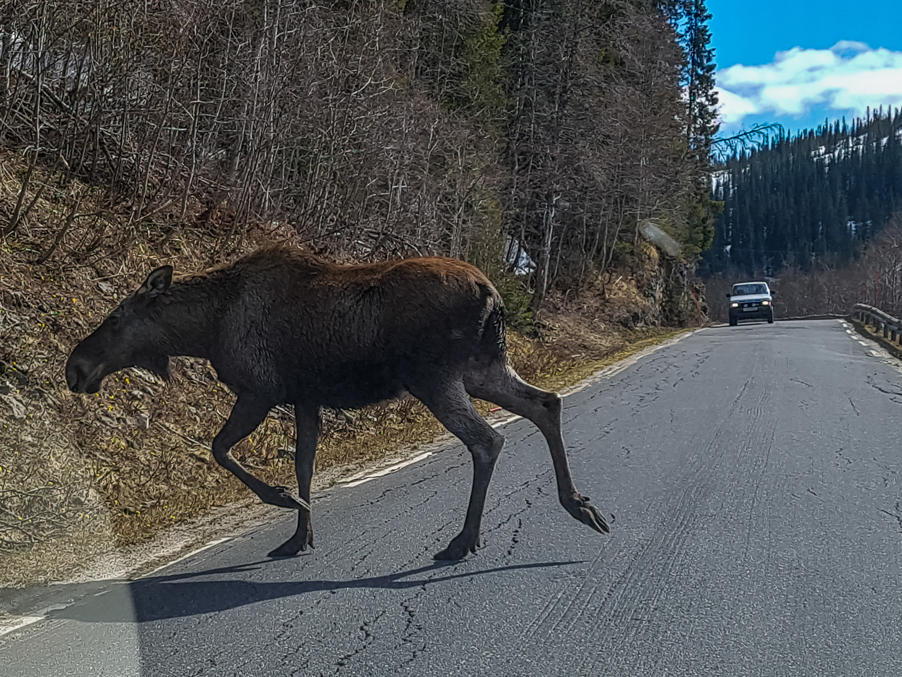
Of course large animals are far more dangerous while driving. These basically are moose and reindeer (bears normally avoid anything to do with humans at all costs, if you wonder). Moose are common pretty much throughout the entire country. They are huge, and can run across the road quite suddenly (especially at dusk), and if you hit them their massive body is likely to land exactly in your windshield and, if you're particularly unluckly, inside your car. So these are really dangerous. Just as they are in Russia, really. Although when you hit a moose in Russia, not only you have to repair your car at your own expense (unless you have an expensive comprehensive car insurance), but you are considered at fault for damaging state property, that is, the moose, and have to pay for it (I believe the mandatory third-party damages insurance should cover that but I'm not sure). In Finland on the other hand you aren't considered responsible for anything, and the damage to your car is covered by a separate animal collision insurance, which is really cheap so everybody has one.
There are moose fences along motorways and some sections of important ordinary highways. The fences however aren't 100% moose-proof, and moose are particularly likely to appear wherever the fences start or end.

Modern motorways also have special wildlife crossing overpasses built like that.
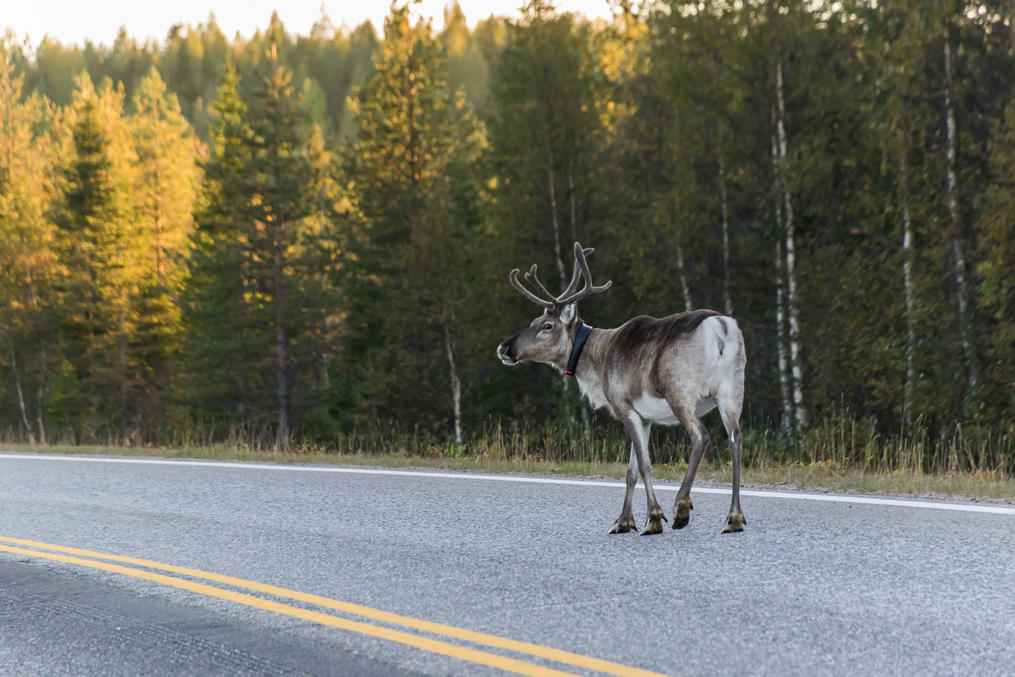
If you're driving to Lapland there's another danger: the reindeer (not to be confused with ordinary deer which are basically like moose but smaller and much rarer). They are far smaller, no bigger than a pony, and behave less unpredictably, but the chances of encountering reindeer are much higher than for a moose. In fact when driving in Lapland you'd be pretty unlikely not to meet any. Whenever tourists see a reindeer for the first time they are usually amazed and get out and take lot of pictures. But after a few times they quickly get sick of reindeer blocking the road yet again. This doesn't apply to me though, I love reindeer!
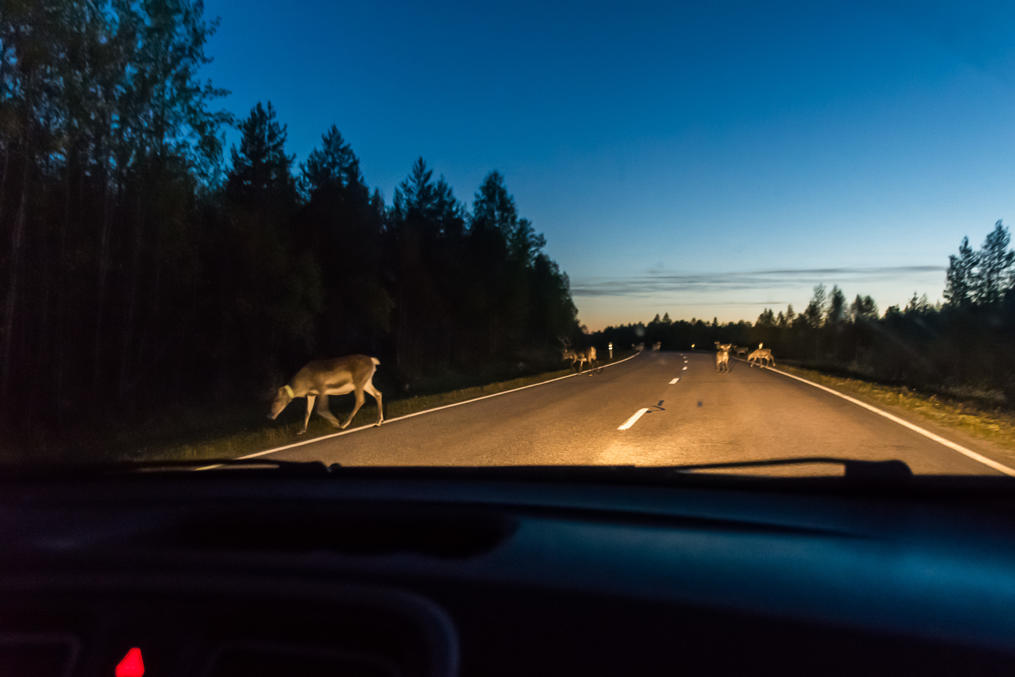
Reindeer are not wild animals; they are herded by the Sami people (although actually in Finland you don't have to be Sami to do this), mostly for meat. They are unlikely to run out onto the road all of a sudden, but they usually occur in groups, and are extremely apathetic about their surroundings. They may even just lie down on the road if they feel like it. Honking is useless; the reindeer will leave whenever they feel like it. Reindeer are mostly dangerous at night, especially in poor weather, where you might not notice them in time. In daytime you probably won't hit them unless you've been sleeping at the wheel. (On the other hand Lapland gets polar nights, so if you go there in winter you're very likely to be driving in the dark for extended periods. There's a lifehack: get tickets to a train leaving from Helsinki to Lapland instead, the one where you can load your car. It's far more pleasant than driving all the way yourself, and not that much more expensive too, given the gas prices in Finland.)
There are huge warning signs on all the roads when you enter reindeer country. The reindeer husbandry areas cover the entire nothern third of the country (and do not match precisely the borders of the Lapland region). The actual reindeer are spread quite unevenly; you can be driving for hours without seeing any, and then it will be one reindeer group after another. This also depends on the season, as summer and winter reindeer pastures are quite different.
Fun roads
And in conclusion, just some pictures of the more noteworthy Finnish roads.
Road 970, Tenojoki Road. Finland doesn't really have many scenic roads (unlike the neighboring Norway), but my favorite one is Road 970. It follows the bank of Teno River, the border river between Finland and Norway in North Lapland, for quite some distance. The river, known as Tana in Norway, is famed for its salmon.
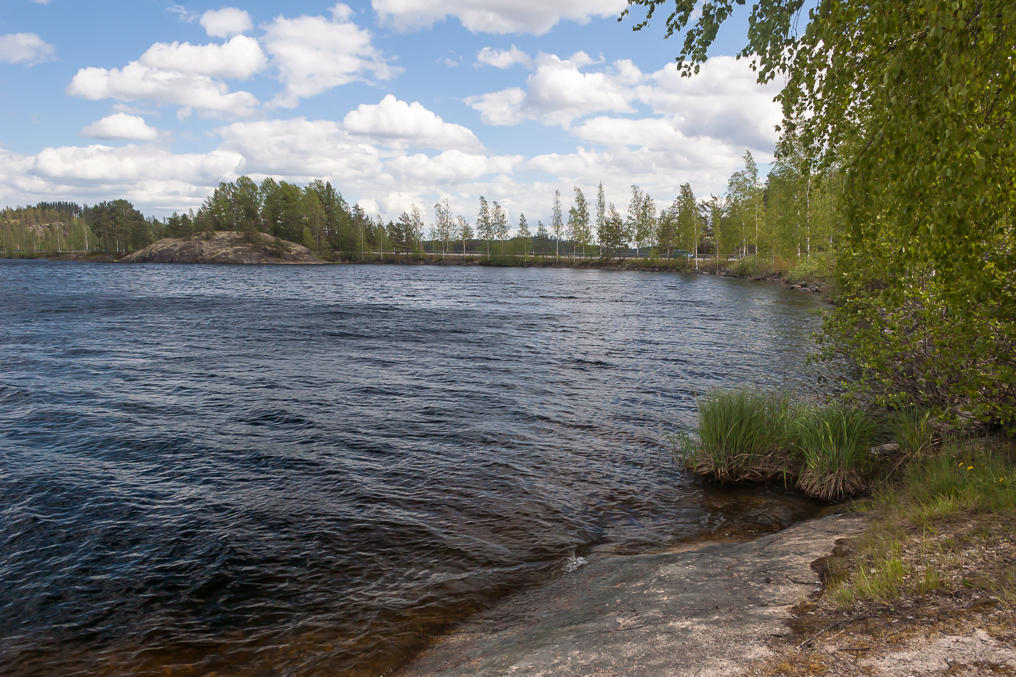
Road 62, Imatra-Puumala-Mikkeli, South Karelia. A scenic road close to the Russian border, hopping between islands and skerries of the Saimaa lake system, connected with bridges and causeways. Another scenic lake road is National Road 14 near Punkaharju.
National Road 29, Kemi-Tornio-Swedish border. The northernmost motorway in the world, and the only one in Lapland. I'm honestly not sure why they bothered to built it; the traffic volumes do not seem to justify it at all. Maybe it's just to make the Swedes envious.
National Road 21, Northern Lights Road, Tornio-Kilpisjärvi-Norwegian border, the northernmost part of the road. This road goes through the only mountainous part of Finland, the northwestern "arm" of Lapland, named Käsivarsi (literally "arm"). Only here Finland just barely touches the Scandinavian Mountains chain, and only here elevations of over 1000 m above sea level occur. The highest point of the public road network is also located on this road, at 565 m above sea level.
Road 940, Kolari-Äkäslimpolo-Muotkavaara. Lapland has a number of secondary roads in remote locations, fairly long (distances in Lapland are usually long in general) and paved, but very narrow, 1.5 lanes wide (4 m). Two cars can usually pass each other in summer while just slowing down a bit, but with trucks or buses or in winter you have to use passing places, which are within line of sight of each other. The traffic on these roads is of course extremely light; one car every ten minutes at best, and sometimes much rarer still.
Replot Bridge on Road 724 (Vaasa-Replot) in Ostrobothnia. The longest bridge in the country, over 1 km long. Connects the Kvarken Archipelago, the only UNESCO natural world heritage site in Finland. The population of the archipelago is less than 2,000; nonetheless a bridge has been built for both them and the tourists.
Reserve military runway on a stretch of Road 88 near Vieremä village in North Savo. Finland has about 20 similar road stretches, which can potentially be used as runways in wartime. Sometimes they actually close down these roads for a while and train landing planes there.
And this is all I'm going to say about Finnish roads for today. In conclusion I can say that highway systems in both Sweden and Norway have quite a lot things different from Finland (especially in Norway). I might write about them too someday, although my knowledge of these countries is a lot more spotty, apart from Northern Norway.
